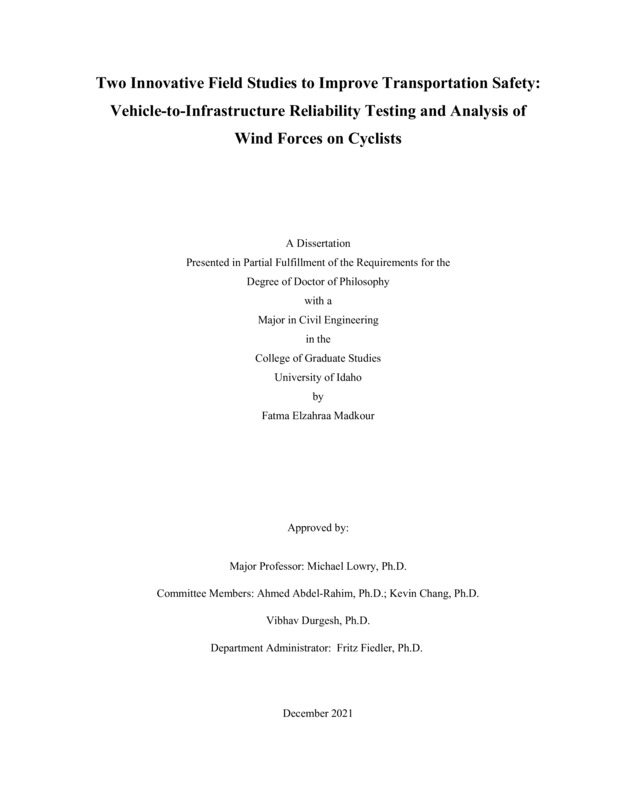Two Innovative Field Studies to Improve Transportation Safety: Vehicle-to-Infrastructure Reliability Testing and Analysis of Wind Forces on Cyclists
Madkour, Fatma Elzahraa. (2021-12). Two Innovative Field Studies to Improve Transportation Safety: Vehicle-to-Infrastructure Reliability Testing and Analysis of Wind Forces on Cyclists. Theses and Dissertations Collection, University of Idaho Library Digital Collections. https://www.lib.uidaho.edu/digital/etd/items/madkour_idaho_0089e_12241.html
- Title:
- Two Innovative Field Studies to Improve Transportation Safety: Vehicle-to-Infrastructure Reliability Testing and Analysis of Wind Forces on Cyclists
- Author:
- Madkour, Fatma Elzahraa
- Date:
- 2021-12
- Embargo Remove Date:
- 2022-12-21
- Program:
- Civil Engineering
- Subject Category:
- Transportation
- Abstract:
-
Each year vehicle collisions are the second leading cause of unintentional death worldwide (following poisoning as the first leading cause). In 2018, 33,650 people died in the United States due to vehicle collisions, including 4,735 pedestrians and 743 cyclists. The same year, there were 66,000 injuries from vehicle collisions. The US Department of Transportation dedicates significant annual financial investment to provide safer streets and improve driving behavior to reduce crashes and fatalities. This dissertation presents two studies aimed at improving transportation safety and reducing crashes. Both studies involved field observations and laboratory simulation. The first study focused on developing a new method for safety reliability testing for connected vehicles-to-infrastructure. The second study investigated safety issues for cyclists when vehicles pass them and exert wind forces. The first study created an innovative method to test the reliability of vehicle-to-infrastructure (V2I) communications in connected vehicles at traffic signals. The new method provides an alternative to using the communication data reported by proprietary vendor-supplied interfaces. This vendor independent method is based on a rigorously tested translation model that uses measured Received Signal Strength Indicator (RSSI) from any V2I communication equipment to predict the corresponding Packet Delivery Ratio (PDR). This was achieved by correlating the signal strength, measured using a generic power meter, to PDR values reported in the communication interface of the equipment of different vendors. Both stationary and in-motion (10 to 40 mph) field data collection tests were conducted at three traffic intersections. These tests were performed over distances of up to 500 meters between the Roadside Units (RSUs) and the On-Board Units (OBUs). The results were statistically analyzed and logistic and linear regression models that predict PDR values were developed. A case study in the field to test and validate this new PDR prediction model was conducted at two intersections in Boise, Idaho. Our prediction model will enable transportation system operators to test and validate the efficiency of connected vehicle RSU/OBU communications at signalized intersection approaches under different traffic conditions, independent of vendor-provided tools. The second study of this research is related to the understanding of the unsteady wind flow exerted on cyclist by passing vehicles. The impact to cyclists from the wind generated by passing trucks has not been investigated before in the USA. In 2017, there was 783 bicyclists killed in crashes with motor vehicles in the USA with an increase of 32% of pedestrian and cyclist fatalities between 2008 and 2017. The aerodynamic loads generated from moving vehicles trigger a concern on the stability and safety of cyclists which might lead to loss of control and consequently cyclist injury. The results of this study will help identify factors to mitigate safety concerns in rural and urban areas. The key parameters investigated were the relative speed between cyclist and truck (25, 40, and 60 mph), vehicle type (semitrailer,. Single unit truck, SUV, and pick-up truck), separation distance spacing between cyclist and the truck (2 ft., 4 ft, and 6 ft.), and various cyclist types. The wind transverse and longitudinal wind speeds have been used to drive equivalent transverse and longitudinal forces using the aerodynamic principles and therefore the flipping moment experienced by a cyclist. The data was generated through intensive field tests in controlled and uncontrolled environments. In addition, computational fluid dynamics models were built to investigate computer simulations in predicting forces on cyclists. Finally, a physical three dimensional model of a scaled truck and cyclist were created and tested in a wind tunnel under the same environments that have been used in the computer simulations. The modeling is based on wind speed equations that are function of vehicle speed, separation distances, and vehicle type. The equations were derived based on the data collected from the field and was validated using the uncontrolled data set. In addition, flipping moment charts have been developed for each type of the vehicles to offer a strong evidence of quantified flipping moments experienced by cyclists under various conditions. The computer simulations concluded that it is feasible to use computational fluid dynamics to model the whole environment of various wind speeds and separation distances for typical cyclists. Strong correlation between the computer simulations and the wind tunnel tests have been obtained. Regardless the scale effect, the overall results from the field tests and the computer simulations and the wind tunnel are showing the same trend in terms of transverse and longitudinal wind forces experienced by cyclists.
- Description:
- doctoral, Ph.D., Civil Engineering -- University of Idaho - College of Graduate Studies, 2021-12
- Major Professor:
- Lowry, Michael
- Committee:
- Abdel-Rahim , Ahmed ; Chang , Kevin ; Durgesh, Vibhav; Fiedler, Fritz
- Defense Date:
- 2021-12
- Identifier:
- Madkour_idaho_0089E_12241
- Type:
- Text
- Format Original:
- Format:
- application/pdf
- Rights:
- In Copyright - Educational Use Permitted. For more information, please contact University of Idaho Library Special Collections and Archives Department at libspec@uidaho.edu.
- Standardized Rights:
- http://rightsstatements.org/vocab/InC-EDU/1.0/

